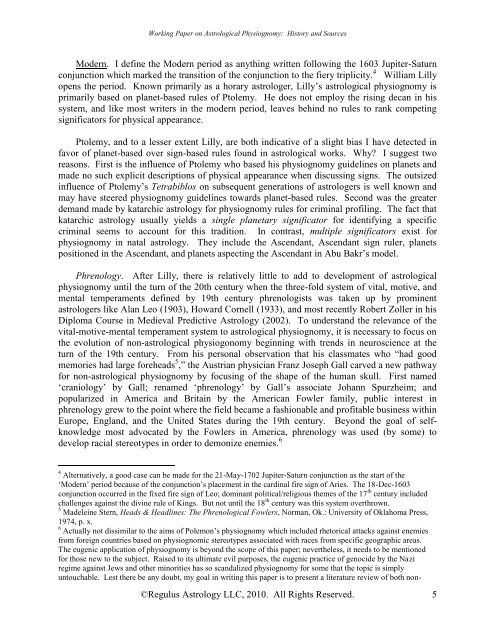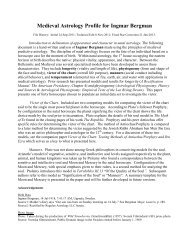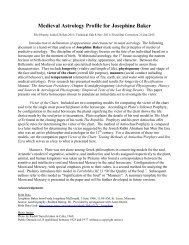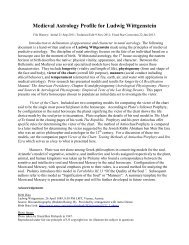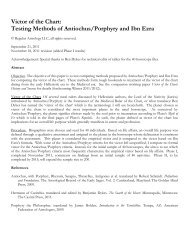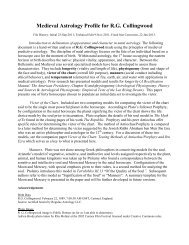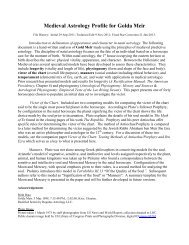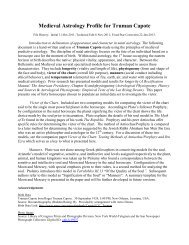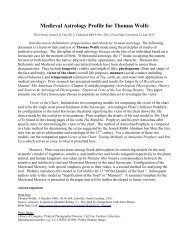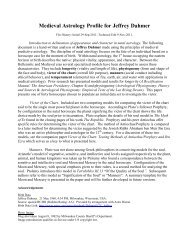Working Paper on Astrological Physiognomy: History and Sources
Working Paper on Astrological Physiognomy: History and Sources
Working Paper on Astrological Physiognomy: History and Sources
You also want an ePaper? Increase the reach of your titles
YUMPU automatically turns print PDFs into web optimized ePapers that Google loves.
<str<strong>on</strong>g>Working</str<strong>on</strong>g> <str<strong>on</strong>g>Paper</str<strong>on</strong>g> <strong>on</strong> <strong>Astrological</strong> <strong>Physiognomy</strong>: <strong>History</strong> <strong>and</strong> <strong>Sources</strong><br />
Modern. I define the Modern period as anything written following the 1603 Jupiter-Saturn<br />
c<strong>on</strong>juncti<strong>on</strong> which marked the transiti<strong>on</strong> of the c<strong>on</strong>juncti<strong>on</strong> to the fiery triplicity. 4 William Lilly<br />
opens the period. Known primarily as a horary astrologer, Lilly’s astrological physiognomy is<br />
primarily based <strong>on</strong> planet-based rules of Ptolemy. He does not employ the rising decan in his<br />
system, <strong>and</strong> like most writers in the modern period, leaves behind no rules to rank competing<br />
significators for physical appearance.<br />
Ptolemy, <strong>and</strong> to a lesser extent Lilly, are both indicative of a slight bias I have detected in<br />
favor of planet-based over sign-based rules found in astrological works. Why? I suggest two<br />
reas<strong>on</strong>s. First is the influence of Ptolemy who based his physiognomy guidelines <strong>on</strong> planets <strong>and</strong><br />
made no such explicit descripti<strong>on</strong>s of physical appearance when discussing signs. The outsized<br />
influence of Ptolemy’s Tetrabiblos <strong>on</strong> subsequent generati<strong>on</strong>s of astrologers is well known <strong>and</strong><br />
may have steered physiognomy guidelines towards planet-based rules. Sec<strong>on</strong>d was the greater<br />
dem<strong>and</strong> made by katarchic astrology for physiognomy rules for criminal profiling. The fact that<br />
katarchic astrology usually yields a single planetary significator for identifying a specific<br />
criminal seems to account for this traditi<strong>on</strong>. In c<strong>on</strong>trast, multiple significators exist for<br />
physiognomy in natal astrology. They include the Ascendant, Ascendant sign ruler, planets<br />
positi<strong>on</strong>ed in the Ascendant, <strong>and</strong> planets aspecting the Ascendant in Abu Bakr’s model.<br />
Phrenology. After Lilly, there is relatively little to add to development of astrological<br />
physiognomy until the turn of the 20th century when the three-fold system of vital, motive, <strong>and</strong><br />
mental temperaments defined by 19th century phrenologists was taken up by prominent<br />
astrologers like Alan Leo (1903), Howard Cornell (1933), <strong>and</strong> most recently Robert Zoller in his<br />
Diploma Course in Medieval Predictive Astrology (2002). To underst<strong>and</strong> the relevance of the<br />
vital-motive-mental temperament system to astrological physiognomy, it is necessary to focus <strong>on</strong><br />
the evoluti<strong>on</strong> of n<strong>on</strong>-astrological physiog<strong>on</strong>omy beginning with trends in neuroscience at the<br />
turn of the 19th century. From his pers<strong>on</strong>al observati<strong>on</strong> that his classmates who “had good<br />
memories had large foreheads 5 ,” the Austrian physician Franz Joseph Gall carved a new pathway<br />
for n<strong>on</strong>-astrological physiognomy by focusing of the shape of the human skull. First named<br />
‘craniology’ by Gall; renamed ‘phrenology’ by Gall’s associate Johann Spurzheim; <strong>and</strong><br />
popularized in America <strong>and</strong> Britain by the American Fowler family, public interest in<br />
phrenology grew to the point where the field became a fashi<strong>on</strong>able <strong>and</strong> profitable business within<br />
Europe, Engl<strong>and</strong>, <strong>and</strong> the United States during the 19th century. Bey<strong>on</strong>d the goal of selfknowledge<br />
most advocated by the Fowlers in America, phrenology was used (by some) to<br />
develop racial stereotypes in order to dem<strong>on</strong>ize enemies. 6<br />
4<br />
Alternatively, a good case can be made for the 21-May-1702 Jupiter-Saturn c<strong>on</strong>juncti<strong>on</strong> as the start of the<br />
‘Modern’ period because of the c<strong>on</strong>juncti<strong>on</strong>’s placement in the cardinal fire sign of Aries. The 18-Dec-1603<br />
c<strong>on</strong>juncti<strong>on</strong> occurred in the fixed fire sign of Leo; dominant political/religious themes of the 17 th century included<br />
challenges against the divine rule of Kings. But not until the 18 th century was this system overthrown.<br />
5<br />
Madeleine Stern, Heads & Headlines: The Phrenological Fowlers, Norman, Ok.: University of Oklahoma Press,<br />
1974, p. x.<br />
6<br />
Actually not dissimilar to the aims of Polem<strong>on</strong>’s physiognomy which included rhetorical attacks against enemies<br />
from foreign countries based <strong>on</strong> physiognomic stereotypes associated with races from specific geographic areas.<br />
The eugenic applicati<strong>on</strong> of physiognomy is bey<strong>on</strong>d the scope of this paper; nevertheless, it needs to be menti<strong>on</strong>ed<br />
for those new to the subject. Raised to its ultimate evil purposes, the eugenic practice of genocide by the Nazi<br />
regime against Jews <strong>and</strong> other minorities has so sc<strong>and</strong>alized physiognomy for some that the topic is simply<br />
untouchable. Lest there be any doubt, my goal in writing this paper is to present a literature review of both n<strong>on</strong>-<br />
©Regulus Astrology LLC, 2010. All Rights Reserved.<br />
5


